 |
| San Diego State University |
It's a real shame that the Chaparral Plant Community gets no more public relations attention other than a bad reputation for being the cause of severe wildfires. Yet no attention whatsoever is focused on the human idiocy side of wildfires. True, climate is changing making fires worse and Nature has indeed caused some lightning fires, but humans cause 84% wildfires. The more humans you get, the more mistakes with fire you are going to have to live with. No amount of brush demonizing will ever change that. Such human caused fires [which generally happen at the most inappropriate times and under the most dire of weather conditions] have to be suppressed to save life and property. It's irrelevant that most all the historical lightning fires usually happen under high humidity scenarios of the monsoon season. So the main focus will always be in favour of magnifying the negatives on Chaparral Plant Ecosystems because it burns so spectacularly.
Or then there is that other bad rap that Chaparral plants get and this is the fact that those plants are just so dull, boring and mundane. They serve no other function other than a mere distraction that has to be tolerated while you are traveling to somewhere with greener pastures like Julian, Idyllwild or Big Bear/Lake Arrowhead. Indeed, most Southern California landowners try and shape their landscape into an imaginary picture of what they think it should be by stripping their land and replacing the native vegetation with those non-natives which are usually doomed for failure before they ever mature. In doing so they destroy the inderground mycorrhizal network which previously kept those non-native invasives weeds and other grasses in check. Strip the land and that all changes. This is the situation I saw this Spring 2013, showed me that things haven't changed since I left in 2002.
I've always liked the chaparral on my land. Of course, I did clean it up a bit of unsightly dead debris from a human visual perspective, but if and when I brought in outside plants, they also were either natives or other southwestern native plants close to the same ecosystem requirements that would allow them to succeed and not be invasive. Mostly I like things that will enhance wildlife on my property. People often forget this, even where moving out to the country to be with Nature, which is why they left the city. Yet quite often, they will often times try and replicate the city from which they came and this is evidenced by their mismanagement. Understandably, learning to care for local natives does take a fair amount of re-education and in severe cases some deprogramming. This past Spring 2013, I saw that nothing has really changed up in Anza landscapes. Although there were some exceptions, like Jim and Margaret Saunders' old Goedesic Dome homestead on Burnt Valley Rd. A French couple live there now and they've done wonders to the place and attracted a lot of wildlife. Many newer developed landscapes I saw had common Retail Nursery Plants brought up from down below in the cities from which the new locals came from. It's understandable, as this is all they know. But Anza and vicinity is a unique region. Whether extremely hot or extremely frigid, it's almost always dry with a wind blowing in from somewhere. For many non-native plants, that saps the life out of them. This is where the natives have the advantage, they're better adapted for just such a life. Although, it is possible to create micro-climates and incorporate more delicate plants later. Below I've created a collection of photographs I took within the chaparral while bush-whacking off trail over there this past Spring. Again, things most people never take note of unless they make an effort to. Forgive me if I don't know all the specific names of things, but I'll try and get close.
 |
| photo: Mine |
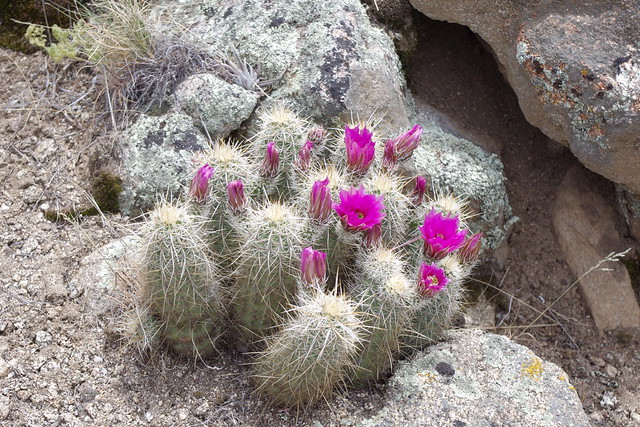 |
| photo: Mine |
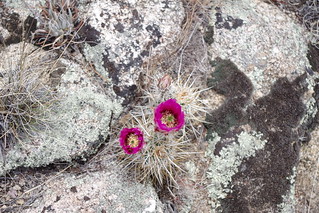 |
| photo: Mine |
Cactus is not exactly what most people picture when they see an ocean of mixed chaparral on a mountain slope. Why cactus is generally considered a strictly desert plant. Actually I have always found many different varieties of cactus colonies within open spaces or underneath the canopies of chaparral plants, especially when I lived in Anza. The Cactus there are a type of prickly pear and the clumping group is a hedgehog cactus. Beavertail cactus are also heavily colonized under many chaparral canopies in high desert chaparral communities. But succulents are also common and again something often overlooked. Most always I have found succulents where there are lots of granite rock. Usually in rocky ravines or dry washes, but even along some streambed canyon walls. Both of these cacti above were found at the same location as the old charred Jeffrey Pine stump field off Hwy 74 at Santa Rosa Mountains.
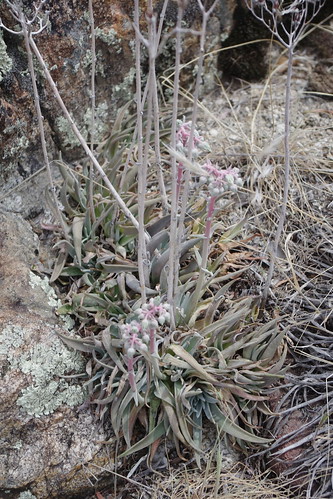 |
| photo: Mine |
I previously wrote about this old forest earlier (Here) . At this time of year in April 2013, the plants should have looked in much better shaped as this was Spring which comes later than down below, but clearly there was evidence of a lousy Winter rainfall season. The western slopes of the mountains fared a little better on Hwy 74, but not by much. The succulent to the left is a type of Dudleya saxosa
which I call Lady Fingers. Believe it or not, this plant's succulent leaves are edible and were a favourite of the Cahuilla Indians. First time I ever saw them was in Mission Gorge Canyon which is within the Mission Trails Park. I'm sure there are many varieties, but above here is one. Then the large Dudleya below which has more of an Agave-like appearance. This one below seemed somewhat different than the San Diego Chalky Live Forever succulent Dudleya pulverulenta I grew up with as a kid, although this one seemed far bigger and this particular plant was on the side of a canyon wall in the Bald Mountain Creek stream bed, which no longer is when I wrote about it (Here) and (Here) .
which I call Lady Fingers. Believe it or not, this plant's succulent leaves are edible and were a favourite of the Cahuilla Indians. First time I ever saw them was in Mission Gorge Canyon which is within the Mission Trails Park. I'm sure there are many varieties, but above here is one. Then the large Dudleya below which has more of an Agave-like appearance. This one below seemed somewhat different than the San Diego Chalky Live Forever succulent Dudleya pulverulenta I grew up with as a kid, although this one seemed far bigger and this particular plant was on the side of a canyon wall in the Bald Mountain Creek stream bed, which no longer is when I wrote about it (Here) and (Here) .
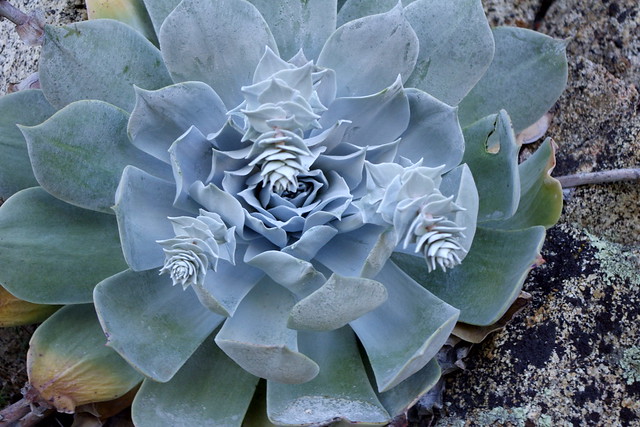 |
| Photo: Mine Most likely a type of Dudleya pulverulenta |
What is very interesting about the toughness of Cacti and succulents native to Southern California is that they can and prefer surviving in this type of setting. Most property owners in the back country will have a soil type that is considered less than ideal garden soils with shallow hard decomposed granite or even boulder outcroppings. These plants are ideal because they don't necessarily require those same deep soils which allow deeper rooted plants to penetrate to acquire subsoil moisture needed during drier periods. Hence, these normally barren areas can be made more colourful and productive with just the right plant placement. I had one dry shallow rocky soil knoll on my land which only allowed a low growing stunted Chamise to grab a foothold. However there were many varieties of naturally occurring Beavertail and other low spreading prickly pear varieties which thrived under their branches. If you have an area where nothing but stunted Chamise or Greasewood will only grow, then leave it. But add colour and texture in the form of various cactus, agaves or Yuccas.
 |
| photo: Mine |
Then there are the plants [mostly perennials] which grow on the margins of chaparral cover, or actually thrive in the understory of the Chaparral Elfin Forest that give added colour to the green canopy. This purplish looking flowering plant on the left was located on the South Fork Trail off Hwy 74 between Valle Vista and Mountain Center. It's called Woolly Blue Curls or (Trichostema lanatum) which was prolifically growing everywhere there was open spaces in the chaparral. They almost have the appearance of Sage from a distance with their long slender stalks of blue flowers. Going back to Santa Rosa Mountains and along Hwy 74, the other plant that will
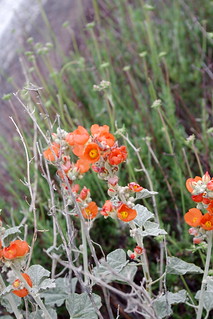 |
| photo: Mine Desert Globemallow |
 |
| photo: Mine Desert Beardtongue (Penstemon pseudospectabilis) |
 |
| photo: Mine Indian Paint Brush Burnt Valley @ Hamilton Creek |
 |
| photo: Mine Chaparral Honeysuckle |
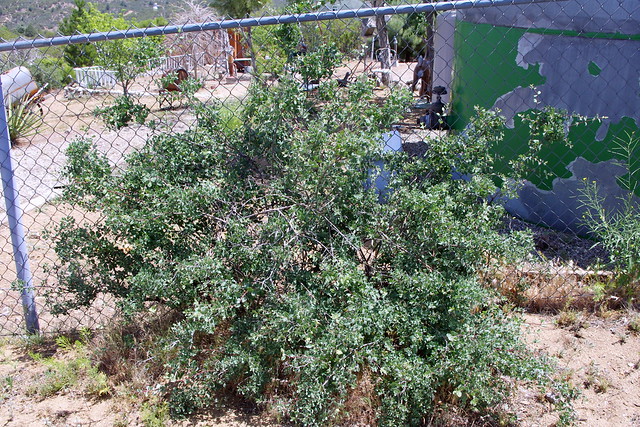 |
| photo: Mine |
 |
| photo: Mine Chaparral Honeysuckle along my old Chain Link Fence |
Here you can plainly see the few plants remaining. Of course the large natural screening is gone, but coming back with a vengeance. It is not hard to go around and find the Chaparral Honeysuckle seedlings, they'll be everywhere, but make sure you get them in late winter or early Spring to transplant quickly. Keep the root moist and make sure to inoculate them at time of transplanting. It may take a few years, but eventually it will all fill in.
Hummingbirds will love them and other birds will nest in the dense plant material. The natural living screen will also take care of itself without fuss. As you can see above, this new owner does nothing as far as watering goes. But more plants are clearly needed in order to fill in the gaps created by the fence reconstruction they did in lowering it. Bottom line here is pay attention to uniqueness of chaparral and also pay attention to replicating some scenes you may want to recreate and incorporate in your native landscape to add colour and texture to that boring mundane Chaparral. People in the urban landscapes use honeysuckle for privacy screens all the time, take this example below.
 |
| Image from Pinterest |
People have multiple decor ideas for which they use honeysuckle, see if you can find some create ideas from these examples in the Pinterest page below:
Pinterest: Explore Honeysuckle Vine
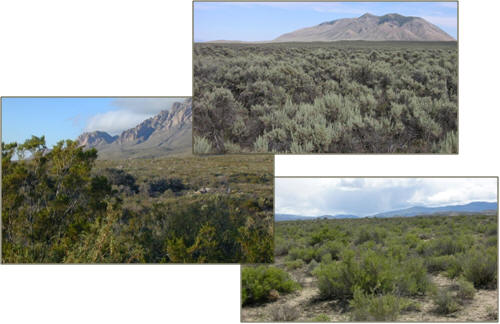
Just wanted to say that I totally agree that native plants and shrubs are the only way we are going to get habitats back. Birds and wildlife have grown accustomed to those natives, and look for them. I wish the local nurseries would be sure to label natives and non-natives instead of selling stuff that really doesn't belong and won't do well. I guess I can always hope!
ReplyDeleteYeah, I was disappointed about the people putting exotics on their property, not because I'm a native extremist or anything like that, but I want them to succeed with their projects. As it stands, most of those plants were struggling.
Delete